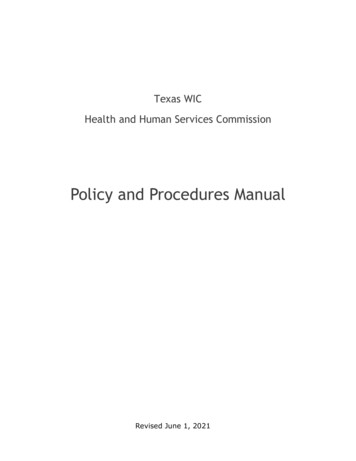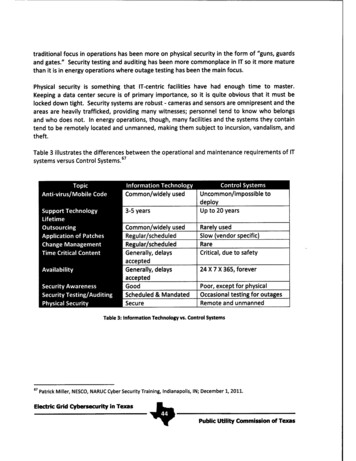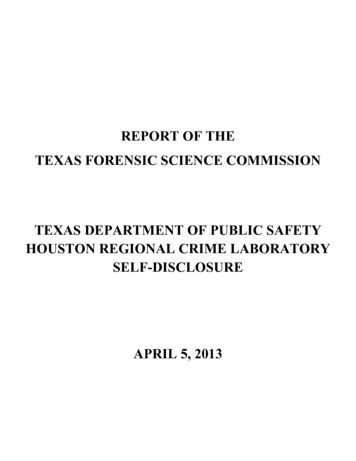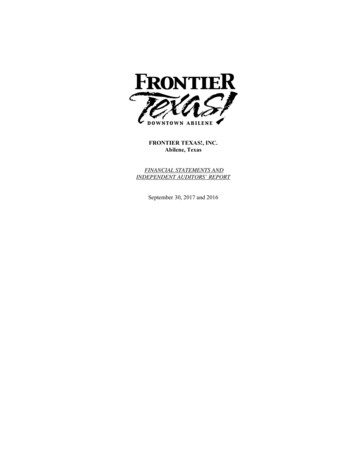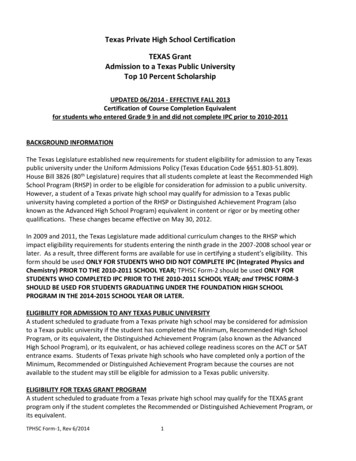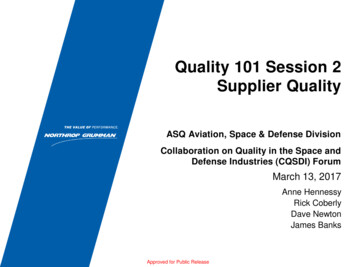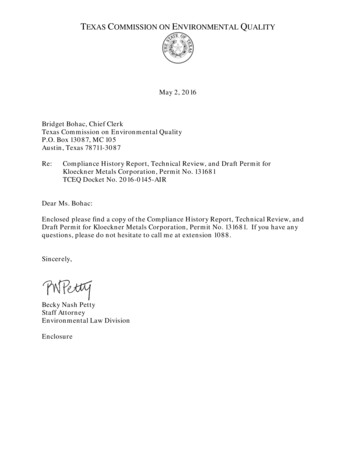
Transcription
TEXAS COMMISSION ON ENVIRONMENTAL QUALITYMay 2, 2016Bridget Bohac, Chief ClerkTexas Commission on Environmental QualityP.O. Box 13087, MC 105Austin, Texas 78711-3087Re:Compliance History Report, Technical Review, and Draft Permit forKloeckner Metals Corporation, Permit No. 131681TCEQ Docket No. 2016-0145-AIRDear Ms. Bohac:Enclosed please find a copy of the Compliance History Report, Technical Review, andDraft Permit for Kloeckner Metals Corporation, Permit No. 131681. If you have anyquestions, please do not hesitate to call me at extension 1088.Sincerely,Becky Nash PettyStaff AttorneyEnvironmental Law DivisionEnclosure
Construction PermitSource Analysis & Technical ReviewCompanyCityCountyProject TypeProject ReviewerSite NameKloeckner Metals CorporationHoustonHarrisInitialStephen Akers, P.E.Metal Preservation LinePermit NumberProject NumberAccount NumberRegulated Entity NumberCustomer Reference Number131681232456N/ARN108250184CN604792085Project OverviewKloeckner Metals Corporation (Kloeckner Metals) has applied for a permit to authorize one (1) automated surface coatingline, one (1) paint mixing room (paint kitchen), one (1) distillation room (solvent recycling room), and one (1) regenerativethermal oxidizer (RTO). These facilities will be located at 14200 Almeda Road, Houston, Harris County. This site will usethese facilities as well as other facilities authorized via permit-by-rule (PBR) to cut, weld, abrasively blast, and surface coatsteel plates and structural steel. The facilities authorized via PBR include but are not limited to welding equipment, anatural gas-fired convection oven, an abrasive blasting booth, and manually operated equipment used for cutting steel.Various other facilities at the site are considered to be de minimis sources under 30 TAC § 116.119. The total annualallowable emission rates for the permit are as follows.Emission SummaryAir ContaminantPMPM10PM2.5VOCNOXCOSO2Exempt SolventProposed AllowableEmission Rates (tpy)0.410.410.414.824.432.220.01 0.01Compliance History Evaluation - 30 TAC Chapter 60 RulesA compliance history report was reviewed on:Site rating & classification:Company rating & classification:If the rating is 50 RATING 55, what was the outcome, ifany, based on the findings in the formal report:Has the permit changed on the basis of the compliancehistory or rating?April 15, 2015N/AN/AN/ANoPublic Notice Information - 30 TAC Chapter 39 RulesRule Citation Requirement39.403Date Application Received:April 6, 2015Date AdministrativelyComplete:April 13, 2015Small Business Source?NoDate Leg Letters mailed:April 13, 201539.603Date Published:April 30, 2015Publication Name:Houston ChroniclePollutants:organic compounds, particulate matter including particulatematter with diameters of 10 microns or less and 2.5 microns orless, nitrogen oxides, carbon monoxide, and sulfur dioxide1
Permit No. 131681Page 2Rule Citation39.60439.41939.41339.60539.603Construction PermitSource Analysis & Technical ReviewRequirementDate Affidavits/CopiesReceived:Is bilingual notice required?Language:Date Published:Publication Name:Date Affidavits/CopiesReceived:Date Certification of SignPosting / ApplicationAvailability Received:Public Comments Received?Hearing Requested?Meeting Request?Date Response to Commentssent to OCC:Consideration of Comments:Is 2nd Public Noticerequired?Date 2nd PublicNotice/Preliminary DecisionLetter Mailed:Date Cnty Judge, Mayor, andCOG letters mailed:Date Federal Land Managerletter mailed:Date affected states lettermailed:Date Published:Publication Name:Pollutants:Date Affidavits/CopiesReceived:Is bilingual notice required?Language:Date Published:Publication Name:Date Affidavits/CopiesReceived:Date Certification of SignPosting / ApplicationAvailability Received:Public Comments Received?Meeting Request?Date Meeting Held:Hearing Request?Date Hearing Held:Request(s) withdrawn?Regulated Entity No. RN108250184May 8, 2015YesSpanishMay 3, 2015La Voz De HoustonMay 8, 2015June 5, 2015YesYesYesYesYesJune 26, 2015N/AN/AN/AJuly 23, 2015Houston Chronicleorganic compounds, particulate matter including particulatematter with diameters of 10 microns or less and 2.5 microns orless, nitrogen oxides, carbon monoxide, sulfur dioxide, andhazardous air pollutantsAugust 7, 2015YesSpanishJuly 26, 2015La Voz De HoustonAugust 7, 2015August 28, 2015YesYesNo meeting held (Number of requests not significant)YesNo2
Permit No. 131681Page 3Rule Citation39.421Construction PermitSource Analysis & Technical ReviewRegulated Entity No. RN108250184RequirementDate Withdrawn:Consideration of Comments:Date RTC, Technical Review& Draft Permit Conditionssent to OCC:Request for ReconsiderationReceived?Final Action:Are letters Enclosed?YesDecember 8, 2015Construction Permit & Amendment Requirements - 30 TAC Chapter 116 RulesRule CitationRequirement116.111(a)(2)(G)Is the facility expected to perform as represented in the application?Yes116.111(a)(2)(A)(i) Are emissions from this facility expected to comply with all TCEQ air quality RulesYes& Regulations, and the intent of the Texas Clean Air Act?116.111(a)(2)(B)Emissions will be measured using the followingRecords of material usage and emissionmethod:factors will be used to determineemissions.Comments on emission verification:None116.111(a)(2)(D)Subject to NSPS?NoNSPS does not apply to this site type since there are no NSPS promulgated formiscellaneous metal parts and products surface coating facilities.116.111(a)(2)(E)Subject to NESHAP?NoNo NESHAPs apply to this operation since the facility does not emit any aircontaminants regulated under 40 CFR Part 61.116.111(a)(2)(F)Subject to NESHAP (MACT) for source categories?NoKloeckner will not be a major source of hazardous air pollutants (HAPs); therefore, 40CFR Part 63, Subpart MMMM (National Emission Standards for Hazardous AirPollutants for Surface Coating of Miscellaneous Metal Parts and Products) is notapplicable. In addition, Subpart XXXXXX is not applicable since Kloeckner is not one ofthe nine source categories which this rule applies to. Lastly, Subpart HHHHHH is notapplicable since the coatings to be used at the site do not contain any of the target HAPs.116.111(a)(2)(H)Is nonattainment review required?NoIs the site located in a nonattainment area?YesIs the site a federal major source for a nonattainment pollutant?NoIs the project a federal major source for a nonattainment pollutant by itself?NoIs the project a federal major modification for a nonattainment pollutant?No116.111(a)(2)(I)Is PSD applicable?NoIs the site a federal major source (100/250 tons/yr of a non-GHG pollutant)?NoIs the project a federal major modification for non-GHG pollutants?NoIs the project a federal major source for non-GHG pollutants by itself?No116.111(a)(2)(L)Is Mass Emissions Cap and Trade applicable to the new or modified facilities?NoIf yes, did the proposed facility, group of facilities, or account obtain allowances tooperate:N/A116.140 - 141Permit Fee: 6,383.79Fee certification:YesTitle V Applicability - 30 TAC Chapter 122 RulesRule Citation Requirement122.10(14)(A)Is the site a major source under FCAA Section 112(b)?Does the site emit 10 tons or more of any single HAP?Does the site emit 25 tons or more of a combination?3NoNoNo
Permit No. 131681Page 4Construction PermitSource Analysis & Technical ReviewRegulated Entity No. RN108250184NoNo122.10(14)(C)122.10(14)(D)Is the site a federal major source (100/250 tons/yr of a non-GHG pollutant)Is the site a non-attainment major source?122.602Periodic Monitoring (PM) applicability: Not ApplicableTitle V is not applicable (not a major source); therefore, periodic monitoring is not applicable. However,periodic monitoring will be performed in the form of quarterly visible emissions checks, records ofpressure drop readings across the paint booth filters, continuous monitoring of the RTO combustionchamber temperature while in operation, AVO inspections of the RTO capture system ductwork, andrecords of material usage in order to demonstrate compliance with their MAERT.Compliance Assurance Monitoring (CAM) applicability: Not ApplicableThe site is not a major source for HAPs or any criteria pollutants; therefore, CAM is not applicable.122.604Request for CommentsReceived :Toxicology:Compliance:Legal:Commentresolution and/orunresolved issues:HoustonHarrisReviewed By/DateCommentsMargaret Dickson5/14/15Comments were submitted by Ms.DicksonN/AScreen3 submitted and not reviewed byADMT.N/AN/AImpacts for all compounds below ESLsNo compliance issuesNo legal issuesAll of Ms. Dickson’s concerns andcomments were addressed in therevised draft permit.Process/Project DescriptionAt the Kloeckner Metals site, stock steel plates and structural steel (steel parts) are received and, if needed, cut to size percustomer specifications. The equipment used to cut the steel parts to size will be authorized via PBR § 106.265. The steelparts are then loaded onto a conveyor line using a crane. Once on the conveyor line, the steel parts move down theconveyor line to an indirect natural gas-fired oven (Preheat Oven) where the parts are heated up. The Preheat Oven will beauthorized via PBR § 106.183. After heating up, the steel parts proceed to the abrasive blast booth where they areabrasively blasted using steel shot. The abrasive blasting booth will be authorized via PBR § 106.452. The steel parts thenproceed into a paint booth (i.e., Primer Booth) where the parts are primer coated using automated airless sprayequipment. After surface coating, the steel parts move down the conveyor line through a drying tunnel where all of thesurface coated parts are dried. Drying of the surface coating in the drying tunnel is aided by warm air from the PreheatOven being routed to the drying tunnel. After exiting the drying tunnel, the painted parts are removed from the conveyorline and shipped to the customer.The primer will be received in 5-gallon buckets and cleaning solvents will be received in 55-gallon drums. All mixing ofpaints and solvents is performed inside the Paint Kitchen. All spray gun cleaning will occur within the Primer Booth withthe exhaust fan on and with the solvent emissions being vented to the RTO. All waste from paint line cleaning will becollected and placed in closed containers for storage prior to recycling in the Distillation Room or being sent off-site fordisposal. The Paint Kitchen and the Distillation Room are both vented to the RTO.Pollution Prevention, Sources, Controls and BACT- [30 TAC 116.111(a)(2)(C)]Emission sources include the following: VOC, PM, and exempt solvent emissions from the surface coating operations (i.e.,painting, cleanup activities, solvent recycling, mixing of paints and solvents) and the drying of surface coatings; and POCsfrom the operation of the RTO. All emissions generated inside the Primer Booth and drying tunnel will be captured and4
Permit No. 131681Page 5Construction PermitSource Analysis & Technical ReviewRegulated Entity No. RN108250184exhausted through filters which have a minimum control efficiency of 99% for PM and then vented to an RTO which has aminimum destruction efficiency of 98% for organic compounds. All VOC and exempt solvent emissions generated insidethe Paint Kitchen and Distillation Room are captured and vented to the RTO.Painting emissions are reduced through a combination of process controls that are as follows: All emissions from the surface coating operations and the drying of surface coatings will be captured and vented to anRTO which has a minimum destruction efficiency of 98% for organic compounds; The use of high transfer efficiency application equipment ( i.e., automated airless spray guns) to reduce coatingconsumption which reduces VOC and PM emissions; The Primer Booth will be equipped with filters which have a minimum control efficiency of 99% for PM; and Good housekeeping practices during application equipment cleanup, and disposal of waste solvent and coatings.These measures are considered BACT for enclosed surface coating operations of this size.Supplemental fuel for the RTO will be pipeline-quality, sweet natural gas. This is BACT for natural gas-fired combustionunits of type.Planned Maintenance, Startup, and Shutdown (MSS)Kloeckner Metals identified a number of process and general facility planned MSS activities to be authorized. A reviewindicates that the identification of activities is appropriate for this type of facility. All of the planned MSS activities at thesite are included in the permit or authorized under a PBR (30 TAC Chapter 106) or are de minimis sources (30 TAC§ 116.119) and have been included in Attachment I.For the activities authorized by the permit, the MSS activities for the surface coating operations have no emissions that aredifferent in character (composition) than the emissions during the normal operations, and the emissions from MSS areintrinsically less than normal operation. The short-term and annual emissions from MSS are already included in theemission calculations because they are based on the maximum amount of coating that may be used in an hour and on anannual basis. The MSS activities for the thermal oxidizer have no emissions that are different in character than theemissions during the normal operations, and the emissions from MSS are intrinsically less than normal operation.Impacts Evaluation - 30 TAC 116.111(a)(2)(J)Was modeling conducted?YesType of Modeling:Screen3Will GLC of any air contaminant cause violation of NAAQS?NoIs this a sensitive location with respect to nuisance?Yes[§116.111(a)(2)(A)(ii)] Is the site within 3000 feet of anyschool?YesAdditional site/land use information: Site is surrounded by a mixture of residences, industrial facilities, and undevelopedland.Summary of Modeling ResultsModeling was performed using SCREEN3 to determine the worst case impacts for each air contaminant from the surfacecoating operations. All surface coating operation emissions will vent to the RTO which exhausts to EPN RTO-1. This stackwas modeled as a point source using an emission rate of 1 lb/hr. The maximum off-property concentration for each aircontaminant emitted from the RTO (EPN RTO-1) was determined by multiplying the unit impact multiplier from thescreen model by the emission rate for that air contaminant. The off-property impacts for all of the air contaminants werebelow their respective effects screening level (ESL). Given this, no adverse impacts to public health and the environment isanticipated.A NAAQS analysis was performed for NO2, CO, SO2, PM10, and PM2.5. The following results were obtained from theanalysis: The impacts for CO (1-hour and 8-hour), SO2 (1-hour, 3-hour, 24-hour, and annual), PM10 (24-hour), and NO2 (1-hour5
Permit No. 131681Page 6 Construction PermitSource Analysis & Technical ReviewRegulated Entity No. RN108250184and annual) emissions were below their respective de minimis impact levels. As such, no further analysis was requiredfor these pollutants and their NAAQS; andFor the PM2.5 emission rates, the maximum off-property concentrations were below the SIL for the 24-hour andannual NAAQS; therefore, no further analysis was required for PM2.5. The 24-hour and annual SILs for PM2.5 werevacated; however, an evaluation was conducted to justify the use of the SILs for this project. Because the differencesbetween the PM2.5 NAAQS and the monitored background concentrations are greater than the PM2.5 SILs, the SILsmay be used for this project’s impacts evaluation. Background concentrations for PM2.5 were obtained from the EPAAIRS monitor 482010058 located at 7210 ½ Bayway Drive, Baytown, Harris County. The monitor selection isappropriate due to a greater amount of industry surrounding the monitor site relative to the project site. Thebackground concentration (22.4 µg/m3) for the 24-hour PM2.5 NAAQS was based on the averages of the 98th percentilefrom the years 2012 to 2014. The background concentration (10.2 µg/m3) for the annual PM2.5 NAAQS was based onthe averages from the years 2012 to 2014. The impacts for this project were below the SILs; therefore, a morecomprehensive cumulative modeling analysis for PM2.5 was not required.Modeling Results for the NAAQSPollutant AveragingTimePM10PM2.5NO2SO2CODe Minimis Less than(µg/m3)De axmodeled(µg/m3)0.350.350.07GLCmax 040,00010,0001503512Given this, the predicted concentrations from the sources at the site will not result in an exceedance of the NAAQS.An analysis was performed for SO2 property line standard for Harris County (i.e., net ground level concentration of 0.28ppmv averaged over any 30-minute period). The following results were obtained from the analysis.Pollutant AveragingTimeSO21-HourGLCmaxmodeled(µg/m3)0.2De Minimis Less than(µg/m3)De Minimis?14.3YesBackground(µg/m3)GLCmax Background(µg/m3)Standard(µg/m3)715Given that the 1-hour impact is less than de minimis, the predicted concentrations from the sources at the site will notresult in an exceedance of the SO2 property line standard.Permit Concurrence and Related Authorization ActionsIs the applicant in agreement with special conditions?Company representative(s):Contacted Via:Date of contact:Other permit(s) or permits by rule affected by this action:YesBruno Ferraro, Grove Scientific & EngineeringE-mail6/17/15No6
Permit No. 131681Page 7Construction PermitSource Analysis & Technical ReviewRegulated Entity No. RN108250184List permit and/or PBR number(s) and actions required ortaken:Project ReviewerDateN/ATeam Leader/Section Manager/Backup7Date
Emission Sources - Maximum Allowable Emission RatesPermit Number 131681This table lists the maximum allowable emission rates and all sources of air contaminants on the applicant’sproperty covered by this permit. The emission rates shown are those derived from information submitted aspart of the application for permit and are the maximum rates allowed for these facilities, sources, and relatedactivities. Any proposed increase in emission rates may require an application for a modification of thefacilities covered by this permit.Air Contaminants DataEmissionPoint No.(1)RTO-1Source Name (2)Air ContaminantName (3)Regenerative Thermal Oxidizer – VOC (5)Primer Booth and AssociatedPM (5)Drying Tunnel, Paint Kitchen,Distillation RoomPM10 (5)Emission Rates (6)lbs/hourTPY (4)0.020.100.090.400.090.40PM2.5 (5)0.090.40NOX (5)1.014.43CO (5)0.512.22SO2 (5) 0.010.01VOC4.304.72Exempt Solvent0.01 0.01PM0.010.01PM100.010.01PM2.50.010.01(1) Emission point identification - either specific equipment designation or emission point number from plotplan.(2) Specific point source name. For fugitive sources, use area name or fugitive source name.(3) Exempt Solvent - Those carbon compounds or mixtures of carbon compounds used as solvents whichhave been excluded from the definition of volatile organic compound.VOC- volatile organic compounds as defined in Title 30 Texas Administrative Code § 101.1NOx- total oxides of nitrogenSO2- sulfur dioxidePM- total particulate matter, suspended in the atmosphere, including PM10 and PM2.5PM10- total particulate matter equal to or less than 10 microns in diameter, including PM2.5PM2.5- particulate matter equal to or less than 2.5 microns in diameterCO- carbon monoxide(4) Compliance with annual emission limits (tons per year) is based on a 12 month rolling period.(5) Products of combustion emissions – regenerative thermal oxidizer.(6) Allowable emission rates include planned maintenance, startup and shutdown activities.Date: Month Day, 2016Project Number: 232456
The TCEQ is committed to accessibility.To request a more accessible version of this report, please contact the TCEQ Help Desk at (512) 239-4357.Compliance History R
Company rating & classification: N/A If the rating is 50 RATING 55, what was the outcome, if . CFR Part 63, Subpart MMMM (National Emission Standards for Hazardous Air . The primer will be received in 5-gallon buckets and cleaning so
